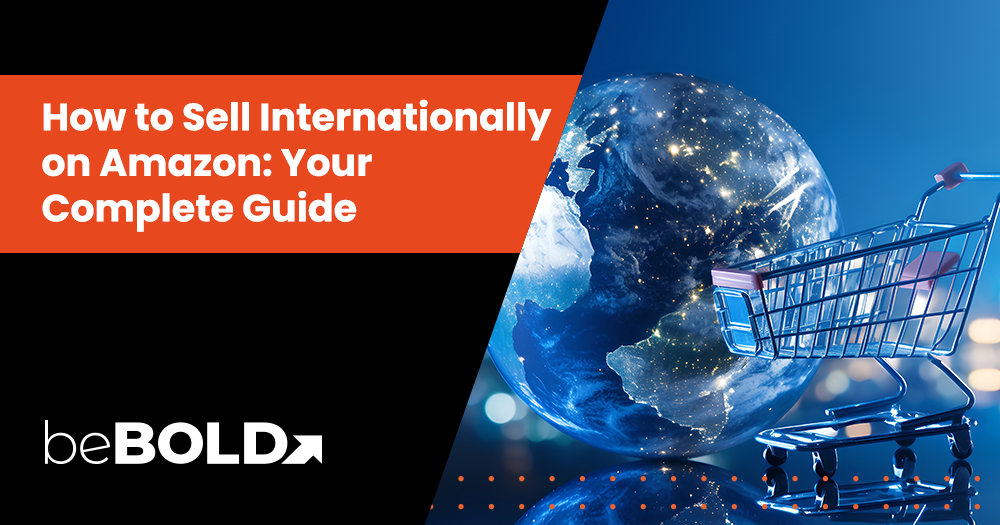Key Highlights
- Amazon Global Selling lets you list products in over 20 international marketplaces with tools to manage logistics, payments, and compliance
- Start by identifying the best-fit markets using demand, competition, and product suitability as your guide
- Understand each country’s legal and tax obligations, including VAT registration, import/export rules, and labeling standards
- Set up the right type of Amazon Seller account—unified for North America and Brazil, or separate ones for Europe and Asia-Pacific
- Optimize listings by localizing language, keywords, and product details using tools like Amazon’s Build International Listings
- Choose between Fulfillment by Amazon (FBA) or Fulfillment by Merchant (FBM) based on scale, control, and cost considerations
- Tailor marketing and customer service to local cultures, languages, and buying behaviors to build trust and boost conversions
- Avoid common mistakes like skipping market research, underestimating logistics, or expanding too fast without infrastructure in place
Selling internationally on Amazon gives your business a passport to global growth. With access to new markets and more customers, it’s a powerful way to scale—but not without its challenges.
This quick guide covers the essentials of Amazon Global Selling, from setup to strategy, so you can expand with confidence and connect with customers worldwide.
Understanding Amazon Global Selling

Amazon Global Selling helps you expand internationally by providing tools to list products, manage orders, and streamline global operations. It simplifies selling across multiple countries, letting you tap into peak shopping seasons and reach new customers worldwide. Amazon Global Selling helps businesses reach customers worldwide by listing products on over 20 international Amazon marketplaces. It simplifies global eCommerce with tools for managing listings, logistics, payments, and regulations, giving sellers control and flexibility to expand beyond their home country.
Overview of the marketplaces available through Amazon Global Selling:
It has access to more than 20 international Amazon marketplaces.
This includes major platforms such as:
- Amazon.com (United States)
- Amazon.co.uk (United Kingdom
- Amazon.de (Germany)
- Amazon.co.jp (Japan)
- Amazon.in (India)
Each marketplace operates independently with its own demand, regulations, and logistics needs. Sellers can choose where to list based on market potential and shipping capabilities.
Is Selling Internationally Right for Your Business?

Selling globally can boost growth, but it comes with challenges. In fact, Amazon’s Global Selling program enabled over $5 billion in exports from India by 2023 (Fibre2Fashion). To succeed, businesses must be prepared for the demands of international operations.
Here are key factors to consider:
- Strong demand for your product in international markets
- Ability to handle international shipping and returns
- Capacity to manage currency exchange and international payments
- Resources for providing customer service in different languages
- Understanding of taxes, duties, and local compliance requirements
- Flexibility to adjust pricing and marketing strategies for different regions
Preparing to Sell Internationally
Once you decide to expand globally, focus on market research, legal and tax requirements, product listings, fulfillment options, and marketing plans. With careful preparation, selling internationally can be a smooth and profitable move.
1. Market Research
Before expanding internationally, it’s essential to choose the right markets. Focus on where your product matches customer demand and where competition is manageable.
Recommended countries for Amazon Global Selling, sorted by opportunity and ease of entry:
- United States (if selling from outside the US)
- Canada
- United Kingdom
- Germany
- Japan
- Australia
- France
- Italy
- Spain
- United Arab Emirates
- India
- Mexico
- Singapore
- Netherlands
- Sweden
Use Amazon’s Global Selling Product Opportunity Explorer to assess demand and competition in each market.
2. Legal and Tax Considerations
Selling internationally comes with legal and sales tax obligations. You’ll need to meet import/export rules, labeling standards, and tax requirements in each country.
Key considerations:
- Understand product restrictions and compliance requirements in target markets
- Ensure proper labeling, packaging, and certifications
- Comply with the import/export laws of both your country and the destination
- Register for VAT, GST, or other local taxes where applicable
- Track and fulfill tax reporting duties for each marketplace
- Consult an international tax advisor before launching
3. Checklist: Before You Expand Internationally
Use this checklist to make sure you are fully prepared:
- Research and select target markets based on product demand and competition
- Verify legal and regulatory requirements for your product category
- Register for any necessary tax IDs or VAT/GST numbers in Poland
- Set up international payment solutions and check currency conversion rates
- Plan logistics, including shipping methods, customs clearance, and returns
- Adapt product listings to local languages and cultural preferences
- Prepare customer service strategies for international buyers
- Evaluate pricing strategies after factoring in duties, taxes, and shipping costs
- Develop a marketing plan tailored to each country’s audience
Setting Up Your Amazon Seller Account

Setting up your Amazon Seller Account for international selling is key for smooth operations across regions. A Professional North America and Brazil unified account lets you sell in the U.S., Canada, Mexico, and Brazil. For Europe, Asia-Pacific, or the Middle East and North Africa, you'll need regional or country-specific accounts.
1. Creating a Unified Account
To sell across North America (United States, Canada, and Mexico) and Brazil, including Saudi Arabia, you can create a Unified Account that allows you to manage all your listings, inventory, and orders in one central dashboard. Here are the steps to create your unified account:
- Sign in to Amazon Seller Central: Create a new account if you don’t have one.
- Select the Unified Account Option: Choose the North America Unified Account to sell in the U.S., Canada, and Mexico.
- Complete Seller Profile: Provide your business, tax, and bank details.
- Set Up Brazil (if applicable): Select Brazil as a marketplace and submit required documents like a tax ID and local bank account.
- Agree to Terms and Conditions: Accept Amazon’s policies for each marketplace you’ll sell in.
- Finalize Account Settings: Adjust country-specific settings such as shipping and currency.
- Start Listing Products: Begin listing products across North America and Brazil from one account.
For other regions like Europe or Asia-Pacific, you will need to create separate country-specific accounts but can link them for easier management through Seller Central.
2. Listing Your Products
Optimizing product listings is essential for success in international markets. Here's how to do it effectively:
- Tailor product titles, descriptions, and keywords for each target country.
- Adapt to local language, shopping behavior, and search habits.
- Use Amazon’s Build International Listings (BIL) tool to sync and translate product details across marketplaces.
- Save time while ensuring consistency in your listings.
Fulfillment and Logistics
Handling fulfillment and logistics for international orders is a critical aspect of selling globally on Amazon. Here's everything you need to know about it.
1. Fulfillment Options
Choosing the right fulfillment method is essential for running your international business efficiently, especially when considering global shipping options. You can opt for Fulfillment by Amazon (FBA) or Fulfillment by Merchant (FBM), each with its advantages depending on your needs.
- Fulfillment by Amazon (FBA): Amazon handles storage, packing, shipping, and customer service.
- Fulfillment by Merchant (FBM): You manage storage, shipping, and customer service, keeping full control of logistics.
- Choosing the Right Option: FBA is ideal for scaling quickly, while FBM may be better if you want to reduce costs and have more control.
2. Shipping and Delivery
Efficient shipping is crucial when selling internationally. It requires planning and understanding customs, duties, and the best delivery options for each region.
- Select Reliable Carriers: Partner with trusted international shipping providers to ensure timely delivery.
- Negotiate Bulk Shipping Rates: Work out shipping deals to minimize costs as your business scales.
- Understand Customs and Duties: Familiarize yourself with each country’s import regulations to avoid delays.
- Consider Amazon Global Logistics: This service helps streamline international shipping and customs processes.
Cost & Profitability Breakdown Per Region
Understanding costs and potential profits in each market is vital to making informed business decisions. Different regions have varying shipping fees, taxes, and exchange rates, which all affect profitability.
- Account for Shipping and Duties: Factor in international shipping costs and local duties when pricing products.
- Use Tools for Currency Conversion: Tools like Wise.com can help calculate exchange rates and provide cost insights.
- Consider Regional Fees: Be mindful of Amazon's referral fees, FBA costs, and tax obligations in each market to accurately calculate profits.
You can also check out Oanda, a comprehensive tool that represents exchange rates. Oanda provides real-time currency conversion and helps businesses understand the fluctuations in exchange rates, allowing for more accurate pricing and profitability calculations across different regions.
Marketing and Customer Engagement

Selling internationally on Amazon requires tailoring marketing to each market’s cultural nuances and consumer behavior. This includes localizing campaigns, optimizing listings, using Amazon Advertising, running promotions, and providing customer service in the local language to build trust.
1. Localizing Your Marketing Efforts
To succeed in international markets, it's essential to tailor your marketing strategies to local cultures, preferences, and languages. Effective localization can help you resonate with your target audience and improve conversion rates.
- Adapting to Local Cultures: Modify your messaging, visuals, and promotions to align with regional values and traditions.
- Language Customization: Translate product listings, ads, and content accurately to reflect local language nuances.
- Utilizing Amazon’s Advertising Tools: Take advantage of Amazon's localized ad campaigns, such as Sponsored Products and Sponsored Brands, to reach customers in specific countries.
2. Customer Service
Providing great customer service is key to building trust and loyalty internationally. Here’s how to improve:
- Support Across Time Zones: Be available during peak hours in different regions. 88% of customers expect a response from your business within 60 minutes.
- Handling Returns and Feedback: Manage international returns and feedback to meet local expectations. 66% of customers are likely to return if the process is easy.
- Adapting to Local Needs: Personalize support based on cultural preferences. 80% of customers value companies that understand their needs.
Monitoring and Scaling Your Business
Expanding globally provides valuable insights. Using Amazon’s analytics tools to track performance helps identify growth opportunities, spot patterns, and understand customer behavior, allowing you to make strategic moves for scaling your business.
1. Analyzing Performance Metrics
Monitoring key performance metrics is essential for understanding your business's success and making data-driven decisions. Tracking the right indicators helps you optimize your strategy and improve overall performance.
- Track Sales and Customer Feedback: Regularly review sales figures, customer reviews, and ratings to identify strengths and areas for improvement.
- Monitor Key Metrics: Focus on conversion rates, return rates, and other key performance indicators (KPIs) relevant to your products and markets.
- Make Data-Driven Decisions: Use performance data to adjust pricing, optimize product listings, and improve customer service strategies.
2. Expanding to New Markets
As your business grows, expanding into new international markets can unlock new revenue streams. Identifying the right opportunities and scaling efficiently is crucial for long-term success.
- Identify Growth Opportunities: Research potential markets based on demand, competition, and logistical feasibility.
- Scale Operations: Ensure your infrastructure can handle increased demand, from inventory management to customer service.
- Maintain Quality and Compliance: As you expand, ensure adherence to local regulations and maintain high-quality standards across markets.
Common Challenges & Mistakes to Avoid

While global expansion comes with ample opportunities, there are also common mistakes that sellers might make. Here are a few challenges along with ways to avoid them:
1. Neglecting Market Research
Neglecting market research can lead to targeting the wrong countries and misjudging demand. 61% of businesses fail due to poor competition analysis, while 70% of consumers prefer companies that understand local culture. (source) Considering local buying behaviors is crucial for successful expansion.
2. Overlooking Local Regulations and Taxes
Not complying with local tax laws, import regulations, and duties can result in delays, fines, or lost sales. Make sure to understand each country’s requirements to avoid costly mistakes.
3. Inadequate Fulfillment Strategy
Choosing the wrong fulfillment method—FBA or FBM—without considering international logistics can lead to high costs and delays. 60% of customers are less likely to buy again after such delays. FBM sellers, in particular, struggle with managing logistics independently.
4. Ignoring Currency and Exchange Rates
Not accounting for exchange rate fluctuations can significantly affect profitability. For instance, a 10% rise in the U.S. dollar's value can reduce S&P 500 earnings by approximately 3%, as reported by Reuters . This underscores the importance of considering currency movements in pricing and margin strategies. (source)
5. Underestimating Customer Support Needs
Failing to provide responsive customer service in local languages or time zones can damage your reputation. Make sure to offer support that aligns with customer expectations in each region.
6. Ignoring Product Listing Optimization
Not adapting product listings to local language, SEO, and market trends can hurt visibility and conversions. 76% of shoppers prefer information in their native language, and sites that localize currencies see a 40% increase in conversion rates. (Source) Optimizing listings for each region is crucial for success.
7. Scaling Too Quickly
Expanding too rapidly without ensuring your infrastructure can handle the growth can lead to issues with inventory management, fulfillment, and customer satisfaction. Scale gradually and maintain quality control as you grow.
Be mindful, learn from these common mistakes, and keep adapting. A strategic approach, careful planning, and openness to learning can go a long way in ensuring success in global selling.
Improve Your Brand's Potential with beBOLD Digital
beBOLD Digital, we lead the eCommerce landscape, specializing in marketplace growth across Amazon, Walmart, and Shopify. Our expert team combines strategic insight, creative precision, and data-driven execution to drive real results.
From launching new products to optimizing Amazon storefronts, we tailor solutions that fuel sales, loyalty, and long-term growth.
With services like marketplace management, SEO, paid ads, and creative branding, we ensure every aspect of your brand thrives. Your growth isn’t just a goal — it’s our mission. Ready to own your space? Partner with BeBold Digital and elevate your brand.
Schedule Your Free Growth Consultation Now!
Conclusion
Selling internationally on Amazon opens up endless opportunities for growth. While it requires careful planning, from market research to managing logistics and understanding regulations, each step is crucial to success. Focus on customer service, adapt to local cultures, and learn from challenges along the way. With Amazon's Service Provider Network tools and guides, global expansion becomes more manageable, and taking gradual, informed steps can lead your business to new heights.
Frequently Asked Questions
What are the costs associated with Amazon Global Selling?
Costs include selling plan fees (individual or professional), referral fees based on product category, fulfillment fees if using FBA, and potential additional fees like currency conversion and storage.
How do I handle currency conversion and payments?
Amazon converts your earnings into your local currency and deposits them into your bank account, using their internal exchange rates and applying a currency conversion fee.
Can I sell in multiple countries simultaneously?
Yes, you can list products across multiple Amazon marketplaces, but you need to manage inventory, pricing, and compliance separately for each region.
What support does Amazon offer for international sellers?
Amazon offers resources like Seller University, Global Selling guides, local language support, and dedicated account managers for high-volume sellers.
Do I need a business entity in each country I sell to?
No, you do not need a separate business entity for each country, but you must comply with local tax and regulatory requirements.
What documents are required to register for global selling?
You typically need a valid government ID, a bank account that can receive international payments, and tax information specific to the marketplace.
What is AGL (Amazon Global Logistics)?
Amazon Global Logistics is a service that helps sellers ship inventory internationally, offering freight forwarding, customs clearance, and tracking.
Can I use one product listing across all regions?
No, you must create separate listings for each marketplace, adjusting for language, currency, and compliance with local regulations.
How do I handle language and customer service requirements?
You are responsible for providing customer service in the local language of each marketplace, either through Amazon's services like FBA or by managing it yourself.
Ready to dominate your marketplace? Partner with beBOLD Digital and turn your eCommerce potential into unstoppable growth.









Comments